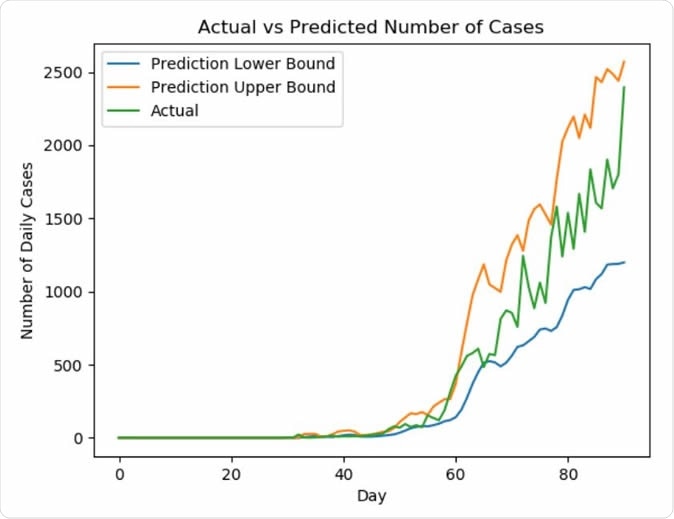Dr. Shinjini Ghosh and colleagues from the Massachusetts Institute of Technology (MIT), United States, have come up with a predictive model that analyzes the spread of COVID-19 infection in India. Their study titled, "Predictive Model with Analysis of the Initial Spread of COVID-19 in India," was released prior to peer review on the preprint server Medrxiv*.

New Delhi, India - March 30th, 2020: Deserted Connaught Place at the time of lockdown due to quarantine for Covid 19, one of the largest business, commercial and financial centres in New Delhi, India. Image Credit: Prabhsas Roy / Shutterstock
Severe acute respiratory syndrome coronavirus 2 (SARS-CoV-2) that causes COVID-19 disease has infected over 3.85 million persons across the globe and led to over 269,000 deaths. Declared a pandemic on March 11 this year, the virus has brought the world to its knees, with economies faltering around the world. Travel has stopped, lockdowns and social distancing have halted most major cities, as over 3.9 billion people, or half of the world's population, have now been asked or ordered to stay at home.
India is the second-most populous country in the world after China and has one of the densest populations. The infection thus has the propensity to spread rapidly in the country. The first case of SARS CoV-2 or the novel coronavirus infection was detected in the Indian state of Kerala on January 30, 2020, in a student who had returned from the epicenter of the infection in Wuhan, China. As of today, India has reported 56,351 cases of COVID-19, and 1,889 deaths due to the disease. The number of cases since the end of January has been steadily on the rise and India has taken measures to break the chain of transmission across the country.
On March 25, 2020, a 21-day lockdown across the country was announced with all non-essential services, and transport between states stopped. Passenger aircraft and domestic and international flights were stopped since March 22, 2020. This lockdown was extended up until May 3, 2020, which was again extended to May 17, 2020.
The authors of the study wrote that this study aimed to analyze the spread of COVID-19 in India using patient statistics and a mathematical prediction model that has been successfully predicting the number of cases on the following day with 83 percent accuracy since the first case was detected in India.
What was done and what was found?
The patient-level analysis showed the demographic distribution of the cases according to age. This was compared with the trends seen around the world. This showed that the average of the patients detected in India was 38.54 (a range of 17.22 years on either side). This study analyzed the age distribution of 2,339 patients. Of the 5,313 patients studied, there were 66.76 percent males. Around the world, slightly more than half of the affected cases are males, the researchers noted.
Recovery rates and time to recovery and death
The assessment is up until April 26, 2020, there were 26,917 cases of the infection, and these 5,914 or 21.97 percent had recovered from the infection with 3.07 percent deaths (826 cases) and 74.96 percent active cases (20,177 cases). The recovery rate in India wrote the researchers is found to be 87.74 percent compared to the global average of 81 percent, said Ghosh.
The average time for recovery among Indian patients was 14.47 days (between hospitalization and official recovery). The average time till death (time between hospitalization and death) was 3.18 days, the study found. The researchers said that this was similar to the WHO and CDC suggestions of average recovery time being two weeks and recovery time is up to 6 weeks in severe cases. Meantime for death around the world, according to WHO is 2 to 8 weeks, however, this is significantly lower in India.

Comparing the Actual and Predicted Number of Daily Confirmed Cases
Transmission of the infection
The researchers tracked the initial cases in India, looking at 3,273 cases, of which 712 patients had traveled from a place where there were active cases, 194 patients had a family member with the infection, and 578 patients who had been in contact with another infected person. They wrote that 911 of these patients had been present at mass gatherings along with infected persons and contracted the infection from there.
Age distribution
It was noted that while in Italy, 71 percent of the cases were over the age of 50 years, in India, only 27.53 percent were over 50 years of age. The team wrote that the "largest number of adults infected being the youngest ones — a departure from the world trend."
Predictive models
The author of the study wrote that several models could predict the spread of the coronavirus infection. Some of the important ones include, "UPenn CHIME model, a discrete-time SIR (Susceptible-Infected-Recovered) modeling of infections/recovery." Others include Health Catalyst, Gauss error function, and Monte Carlo simulation.
One of the models, Ghosh said, predicted the number of cases in India by the end of May to be 13,000. However, the present scenario shows over 35,000 cases at the start of May which is three times what had been predicted to be the number at the end of the Month. Yet another model had predicted 10,000 cases at the end of April. This was also one-third of what was actually seen.
This study thus used a different mathematical model to predict the numbers. They defined what is called a "change factor." Change factor is defined as "a measure of the ratio of the daily increase with respect to the past N days."
Using this model, they attempted to see the predicted numbers over the 74 of the coming 90 days. Their calculations found that there is a deviation of 61 cases from the actual value. They wrote, "This is a mere 3.21% of the maximum daily cases reported in this period, and just 3.39% of the latest day (April 30, 2020) 's reported cases."
Conclusions and future directions
The author wrote that there is an "alarming growth in the number of cases in India over the last month." However, there is also a "silver lining in the current 'stabilizing' nature of trend factors, possibly owing to the lockdown measures implemented, along with widespread testing, contact tracing, and general hygiene measures." They write that there is a different age distribution seen in India with the younger population more affected. They add, however, "The quick turnaround of recovery in infected patients in India is another beacon of hope." They plan for modifying this model to predict the actual numbers seen in India. "Brief investigation into the list of change factors shows that a factor that stays around 1.0 indicates a 'stabilization' in the daily number of confirmed cases," the author wrote in conclusion.

 This news article was a review of a preliminary scientific report that had not undergone peer-review at the time of publication. Since its initial publication, the scientific report has now been peer reviewed and accepted for publication in a Scientific Journal. Links to the preliminary and peer-reviewed reports are available in the Sources section at the bottom of this article. View Sources
This news article was a review of a preliminary scientific report that had not undergone peer-review at the time of publication. Since its initial publication, the scientific report has now been peer reviewed and accepted for publication in a Scientific Journal. Links to the preliminary and peer-reviewed reports are available in the Sources section at the bottom of this article. View Sources